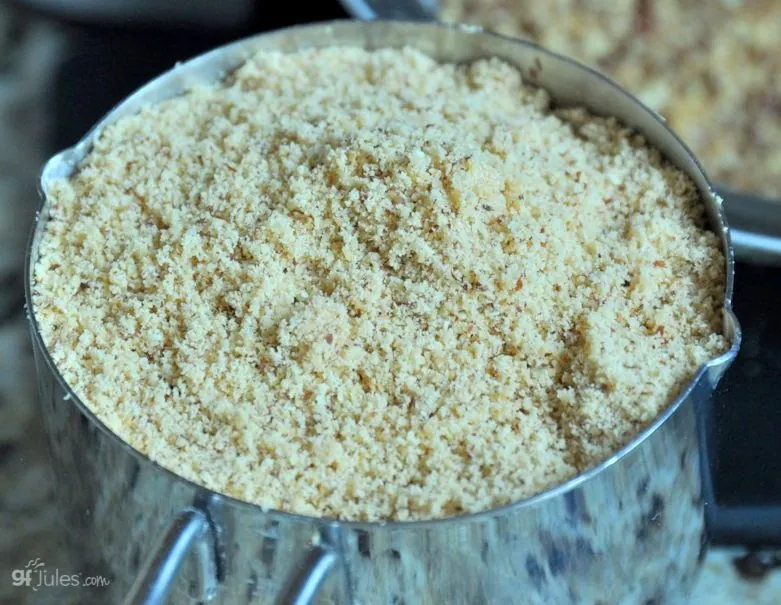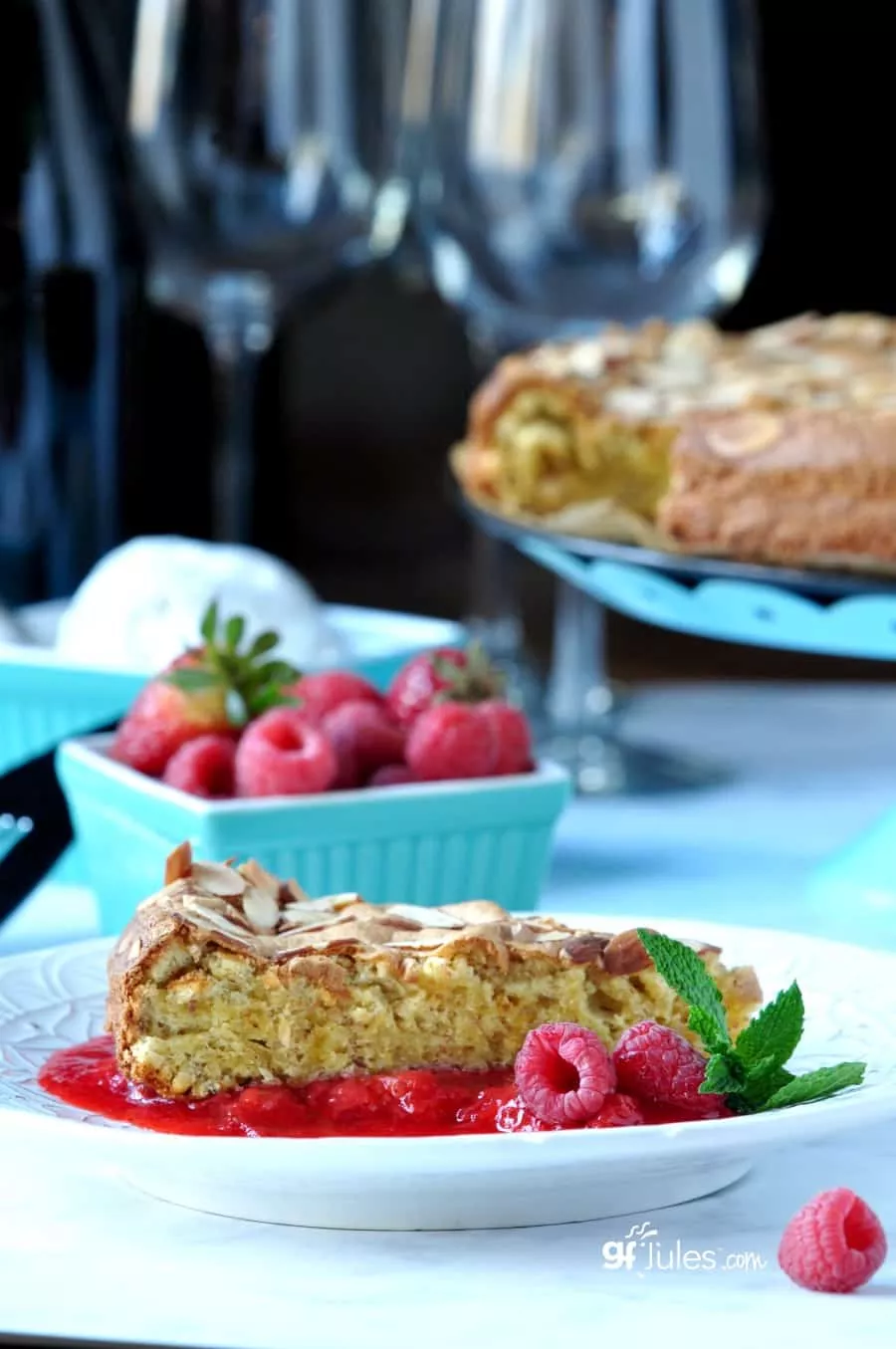Making homemade almond flour or gluten free oat flour is not only easy, it’s practical and so much more economical.

Both of these gluten free flours are higher in fat and protein than starches or even my gfJules all purpose flour blend, hence, they become rancid more quickly and should be refrigerated. This is another great reason to make your own gluten free almond or oat flour fresh each time you need it for a recipe!
Making fresh almond flour or oatmeal flour for your recipes will ensure that you don’t waste flour that you cannot use quickly enough. These flours also tend to be pretty pricey, so I highly recommend making your own.
What’s the Difference Between Almond Flour and Almond Meal?
Almonds can be ground into either almond flour or almond meal. These “flours” are different consistencies: almond flour is the finer ground version of almond meal.
Do I need to toast the almonds before grinding into flour?
You don’t need to toast the almonds first, unless you love the taste of almonds, and want to enhance that flavor for your flour. Some people also find that toasting almonds makes them easier to digest. If you decide to toast the almonds, spread the almonds on a cookie sheet and lightly toast for about 10 minutes, tossing at the 5 minute mark, but watch to be sure they don’t burn.

Do I need to use blanched almonds to make almond flour?
I prefer not to use blanched almonds for grinding (blanched almonds have the brown skins removed), since the skins contain a lot of nutrients and their added texture doesn’t bother me. If you want whiter almond flour or if you want the finest flour you can get though, use blanched almonds as your base.
If you choose not to use blanched almonds, you can always sift out any larger pieces after grinding, to make the flour even finer.
How do I grind almonds to make almond flour or almond meal?
To make almond flour or almond meal, simply measure the amount of almonds you need for your recipe and process in blender or food processor just until the meal or flour fineness you want is made — no more. With almonds or any nut you need to watch closely that you don’t over-process or the nut oils will release and you’ll make nut butter instead of nut flour!

How Do I Make Safe Gluten Free Oat Flour?
To make gluten free oat flour, be sure to select certified gluten free purity protocol rolled oats, like those I offer in my on-line store. It can be difficult to find CERTIFIED glute-free oats in regular grocery stores (most just claim gluten-free without an independent certification), and even more difficult to find purity protocol oats.
For more on distinguishing between gluten-free claims on oats, visit my article on shopping for safe gluten free products.

For making gluten-free oat flour, I prefer to use rolled oats rather than steel cut oats because they seem to grind into flour more easily, but you can ultimately use either if it’s all you have on hand.
Simply measure the amount of gluten-free oats you need for your recipe, pour into a blender or food processor, and process until fine. At that point, re-measure to proper amount for your recipe.

How Do I Bake with Almond Flour or Oat Flour?
Both almond flour/meal and gluten free oat flour can be used to increase the nutritional value of gluten free baked goods (see my Gluten Free Pineapple Upside-Down Cake recipe for a recipe with gluten-free oat flour and my Gluten-Free Lemon Almond Cake for a recipe with gluten-free almond flour), and they can even be used with some success as a replacement for milk powder in many recipes.
These gluten free flours do add weight and density to recipes though, so they are not well-suited for delicate baking.

In my gluten-free Pineapple Upside-Down Cake, for example, you’ll notice that the texture is more chewy than a cake made with just my gfJules Gluten Free All Purpose Flour blend. This makes for a denser cake, but one that has a fuller flavor and texture, as well. Not bad, not better, just different.
There are lots of differences between gluten-free flours; never just swap almond or oat flour in a recipe calling for all purpose flour or visa versa. So study up on their properties for baking, as they are not simple 1:1 exchanges for wheat flour.

Homemade Almond Flour
Ingredients
- 1 cup whole almonds
Instructions
To make 1 Cup Almond Flour/Meal:
- Measure out 1 cup of whole, unblanched almonds (may use blanched almonds, but since their skins are removed, they are less nutrient-dense). Place them into a clean coffee grinder, blender or food processor – depending on the size of your machine’s bowl, you may need to divide the almonds into two portions and process separately.
- Cover with the lid and pulse, grinding the almonds into meal. (This recipe will work with a fine almond flour or a coarse almond meal). Be careful when grinding almonds or other nuts, as over-processing will quickly take flour/meal to nut butter! Stop processing when the almonds are ground to small chunks but not flour-like if you're making almond meal; keep processing to make almond flour.
- Sift the meal to remove larger pieces, allowing the fine particles to settle into a separate bowl. Repeat until all the medium-large pieces are separated and processed until fine.
- Measure out 1 cup of almond flour/meal and reserve any extra by placing in a zip-top bag and refrigerating for up to one month for use in another recipe.
** Please keep in mind that nutrition information provided is per serving, which may vary. While we have taken care to provide you with the most accurate nutritional values possible, please note that this information may differ significantly depending on the exact ingredients and brands that you choose to use to make this recipe. Additionally, where options are given for ingredients, the resulting calculation may include all ingredient options instead of only one per line, skewing the totals significantly.

Homemade Gluten Free Oat Flour
Equipment
Ingredients
Instructions
To Make 1 Cup Gluten Free Oat Flour:
- Measure out 1 cup of certified gluten free purity protocol oats. Place them in a clean coffee grinder, blender or food processor – depending on the size of your machine’s bowl, you may need to divide the oats into two portions and process separately.
- Cover with the lid and pulse, grinding into a fine flour. Measure out 1 cup of oat flour and reserve the remaining in a small zip-top bag and refrigerating for up to one month for use in another recipe
Video
** Please keep in mind that nutrition information provided is per serving, which may vary. While we have taken care to provide you with the most accurate nutritional values possible, please note that this information may differ significantly depending on the exact ingredients and brands that you choose to use to make this recipe. Additionally, where options are given for ingredients, the resulting calculation may include all ingredient options instead of only one per line, skewing the totals significantly.


























Thanks for the money saving tip! I buy your gluten-free oats but now I can make gluten-free oat flour, too!
All oats are gluten free
Hi Holly, oats are indeed naturally gluten free, but they have been so contaminated with gluten grains that it’s important that they be grown, harvested, milled, packed, etc. in a dedicated gluten free environment in order to keep them gluten free. Thus, it’s recommended that those with celiac disease and gluten sensitivity only eat purity protocol, certified gluten free oats. I hope that helps!
~jules
Hi! If a recipe calls for oat flour, can you swap it with almond flour evenly? It seems like their weight is about the same…
Hi Melanie, great question! The weights are fairly close, but they absorb moisture at a different rate. Oat flour tends to need a bit more liquid in a recipe than does almond flour, so watch out for that — if you get crumbly recipes you’ll know to add more liquid!
~jules
Thanks for sharing your thoughts about gluten free oats.
Regards
The sticky cinnamon roll recipe calls for almond meal. Can almond flour be used instead? Tring to avoid a trip out before the holidays!
Thank you!
Hi Wendy, yes almond meal or flour would work. Enjoy!
If a recipe calls for almond flour, can Jules Gluten free be used instead? Do the amounts need to be adjusted?
Good question, Tricia! Almond flour is really quite different from regular flour, and usually when a recipe is written for 100% almond flour, there will need to be adjustments if using something else. If a recipe calls for a little bit of almond flour, plus some other flours, and you want to sub for that small amount of almond flour, it will probably work out. Almond flour has higher fat and moisture than does my Jules Flour, so the recipe probably accounted for that in proportions. If you want to use my flour instead, I would start by increasing the fats used and reducing the amount of flour. If you’ve made the recipe before, you may know what to expect as far as the batter or dough, but just know that almond flour tends to make a thicker batter than regular wheat flour or my Jules GF Flour. Hope these tips help!
Hi Jules!
That’s my nickname too.
I’m allergic to almonds. Can I process raw cashews or brazil nuts to substitute?
If not, what else might I sub with?
Thnak you!
I love your site. Just found it thanks to an amazon reviewer. I’m going to make beer burger buns! Maybe make them into onion rolls! yum!
Hi Julie/Jules So glad you found my site! You can use alternative nuts but be careful because soft nuts like cashews can start turning to “cashew butter” rather quickly – there’s a fine line between well-chopped and butter with those soft, fatty nuts! I’m so glad you’re going to try the beer burger buns, and making them into onion rolls sounds FANTASTIC!!!
So glad you found my site! You can use alternative nuts but be careful because soft nuts like cashews can start turning to “cashew butter” rather quickly – there’s a fine line between well-chopped and butter with those soft, fatty nuts! I’m so glad you’re going to try the beer burger buns, and making them into onion rolls sounds FANTASTIC!!!
Thanks for sharing your thoughts on gluten free oats.
Regards
what is the differance between using your GF flour and Nearly Normal GF flour
Hi Barbara, in any of my early recipes calling for Nearly Normal Gluten-Free Flour, you can use my Jules Gluten Free Flour. The Jules flour is quite different in terms of ingredients and proportions, and it works wonderfully in all the recipes. Hope that helps!
We stumbled over here from a different web address and thought I
should check things out. I like what I see so now i’m following you. Look forward to finding out about your web page yet again.
Do you use raw or roasted almonds to make the flour?
I’ve realized that making gluten free items are better than the packaged stuff. Thanks for the recipe!
Thanks for sharing! I’ll definitely have to try this one out. I’ll let you know how it goes. Thanks again!